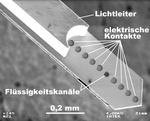A Light Switch inside the Brain
Direktzugriff
Artikelaktionen
Source: IMTEK, Universität Freiburg
Activating and deactivating individual nerve cells in the brain is something many neuroscientists wish they could do, as it would help them to better understand how the brain works. Scientists in Freiburg and Basel, Switzerland, have developed an implant that is able to genetically modify specific nerve cells, control them with light stimuli, and measure their electrical activity all at the same time. This novel 3-in-1 tool paves the way for completely new experiments in neurobiology, also at Freiburg’s new Cluster of Excellence BrainLinks-BrainTools.
Birthe Rubehn and her colleagues from the Department of Microsystems Engineering (IMTEK) and the Bernstein Center of the University of Freiburg as well as the Friedrich Miescher Institute for Biomedical Research in Basel describe the prototype of their implant in the journal Lab on a Chip. They report that initial experiments in which they implanted prototypes into mice were successful: The team was able to influence the activity of nerve cells in the brain in a controlled manner by means of laser light pulses.
The team used an innovative genetic technique that brings nerve cells to change their activity by shining light of different colors onto them. In optogenetics, genes from certain species of algae are inserted into the genome of another organism, for instance a mouse. The genes lead to the inclusion of light-sensitive pores for electrically charged particles into a nerve cell’s membrane. These additional openings allow neuroscientists to control the cells’ electrical activity.
Read more (press release of the University of Freiburg, 18.01.2013)
Fußzeile
Benutzerspezifische Werkzeuge

